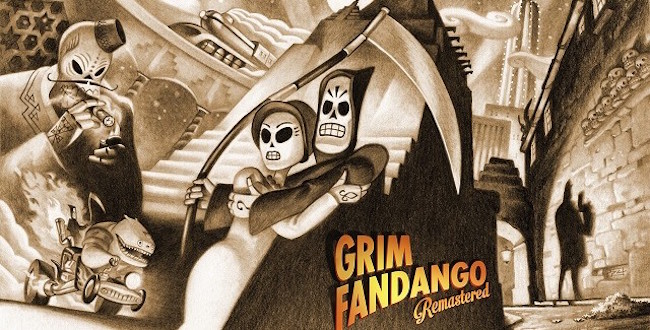
Grim Fandango: the game I never played but always wished I had. Until now it was a relic from another era, also out of reach from digital distribution due to licencing issues with Lucasarts and unplayable (without mods) on modern PCs. It was also a commercial flop in 1998 despite its critical acclaim and was perhaps the last nail in the coffin for the adventure game genre. The whole genre is steeped in nostalgia, especially as truly great titles have been few and far between in the past 10 or so years. In recent times Telltale Games have embraced the genre and produced the amazing Walking Dead and Wolf Among Us series, while resurrecting our favourite “pirate” and leather jacket salesman Guybrush Threepwood in the Tales of Monkey Island. Indie developers such as Harvester Games (makers of the disturbing yet excellent The Cat Lady) have also taken up the mantle, and I suspect I know the reason behind the resurgence: nostalgia. Ah yes, they just don’t make them like they used to – and as our rose-tinted-glasses minds may choose to overlook: there’s usually a good reason for that. So here we are, 17 years later (wow, I’m old) with just one question: does it hold up?
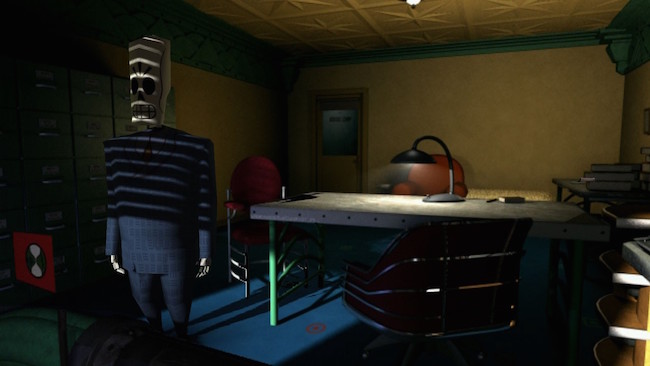
While gameplay and graphics may fade, a well written story is timeless. Grim Fandango is loaded with the wit, charm and humour that we’ve come to expect from a Tim Schafer game, not to mention the colourful characters who pop up along the way. The story is based heavily on the Aztec belief of the afterlife and a healthy influence of film-noir, especially films such as Casablanca and The Maltese Falcon. Our hero Manuel “Manny” Calavera is a travel agent for the Department of the Dead in the Land of the Dead who sends freshly departed souls on their required four-year journey through said Land to the Ninth Underworld, the comfort and speed of the trip determined by how virtuous they were in life. The best way to travel is the Number Nine express train that reduces the trip to four minutes. After a run of bad clients Manny decides to steal his rival’s client, a woman named Mercedes Colomar, who turns out to be a perfect candidate for the Number Nine but is inadvertently assigned the four-year walk instead. She disappears and Manny sets off to find her on his own four-year journey where he slowly unravels the layers of greed and corruption embroiling the Land of the Dead.
The second chapter (or Year as the game puts it) is easily Grim Fandango’s high-point as we find Manny running a Casino in port-town Rubacava, surrounded by a cast of lowlifes, villains, cool-cats, dead-beatniks (get it?) and demon-mechanic friend Glottis. The reason this chapter works so well is how the over-arching puzzle (get on a boat to chase after Mercedes) takes so many twists and turns as the many inhabitants of Rubacava play a part in unfolding the story and the puzzle. Years 3 and 4 drop the ball a little in this respect as they’re focused more on the puzzle than the rest of the story. We never do find out why Manny was stuck in the Land of the Dead or why he had a debt to pay (from his previous life), only that he feels he deserves his station in life/death. This string of narrative could have been expanded further, but I think the story’s focus on Manny’s search for Mercedes rather than introspective soul searching (so to speak) did the game a huge favour.
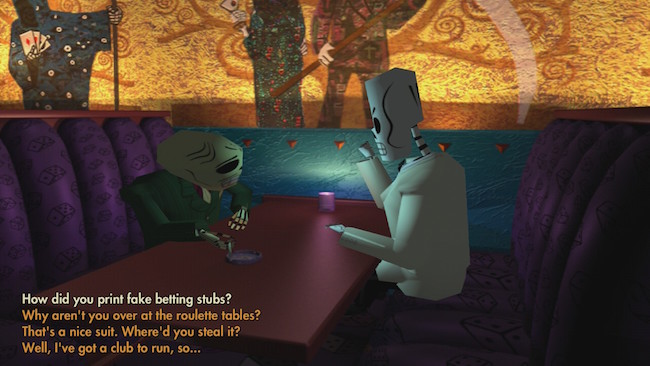
Let’s get one thing clear here: remastered, in this case, certainly does not mean re-made. All the faults and foibles of the original game are still here, not to mention the clunky inventory system or tank controls. To its credit, Grim Fandango is a game without a UI or any other clutter on the screen, allowing you to dive into that sweet, sweet immersion. Grim Fandango followed suit from 1995’s Full Throttle dispensing with the classic verb selection UI and using a simple “look, use, pick-up” context menu. It still works well and allows the player to reason out puzzles rather than simply be rewarded for finding the right pixel. Manny has a unique quip for almost every item and situation you could think to use them for, a feature I’ve always loved in Tim Schafer adventure games. Less enjoyable are the long treks you’ll have to take in some areas going from scene to scene, especially when it becomes less clear as to what you’re meant to be doing.
A hallmark of point-and-click games (although originally Grim Fandango was purely tank controls, no clicking required) is collecting obtuse objects, usually with little reason obvious use, and then finding a completely obscure way to solve a puzzle with them – Grim Fandango keeps the tradition alive and well. The puzzles in Grim Fandango are generally well designed, especially in the case of the Year 2, but there will be quite a few times where you’ll be utterly stuck. The forest puzzle is particularly notorious, and there’s a few puzzles that require a bit of pixel-hunting and very creative thinking. It would be surprising if a new player to the game could make it through without alt-tabbing and consulting a guide, or even resist the urge to do so (I did, will hand in my gamer card at the end of the shift). As previously mentioned, Year 2 is the high-point of the game thanks to the way the puzzles are intertwined with the characters and story of the area. Manny dons a suave white suite and makes the role of nightclub owner his own, but needs to get out of town quick when he finally finds Mercedes. This leads Manny to needing a boat, which of course requires a few items and conditions to board, those tasks of which then needs more puzzles to be solved, all while meeting the diverse denizens of Rubacava. It’s interesting, intriguing, frustrating occasionally, but otherwise an enjoyable experience.
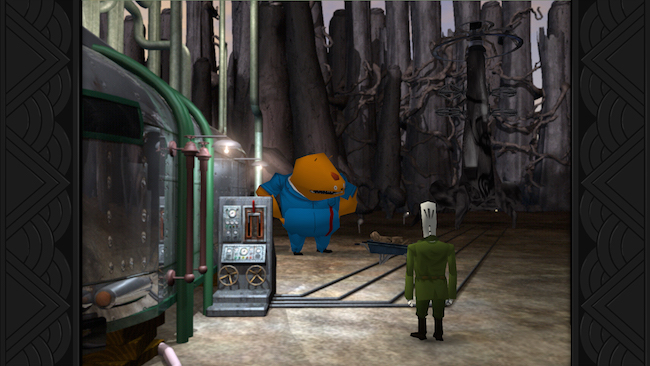
Do you know what other highly-praised title was released in 1998? Half Life. Another game that’s definitely showing its age, but it’s also a damn well-built game even by today’s standards. Sure there’s no iron-sights, mini-maps or smart-phone integration (for the best really), but it still represents the immersive experience to strive for in video games. Grim Fandango, by comparison, was quite frankly a pain in the arse. The original gave the player tank controls, and Manny’s moving head to help them navigate puzzles and the environment. This meant gradually manoeuvring Manny in every possible way depending on where he was looking, and which angle the camera is facing, and hoping you’re not missing anything. It was a game for the patient and devoted, rewarding to those who stuck it out. The remaster now has point-and-click controls, which makes life a million times easier. I’d say my playtime was several hours shorter as a result, and Grim Fandango is by no means a short game.
Like most games of this ilk Grim Fandango’s gameplay is mostly made up from conversations with other characters, inspecting EVERYTHING, and trying to stick everything in your inventory into that thing you can’t get to work. In Remastered with the updated controls this becomes a whole lot less tedious, but nothing will help you when you’re stuck. Perhaps it’s a sign of the times, or at least how spoiled we are these days, as I kept expecting to see a hint appear to no avail. The game does organically drop hints through scenery or dialogue, just be prepared for it to make sense after you’ve fluked it. Other times it’s purely guesswork, which can feel cheap as they lack context or feel tacked on for the sake of a puzzle. The thrill of completing a puzzle is the big payoff here (aside from continuing the story of course) and luckily there’s a good diversity from simple “give x to y (after you find x)” to timing based puzzles, some of which as mentioned before require more thought than others.
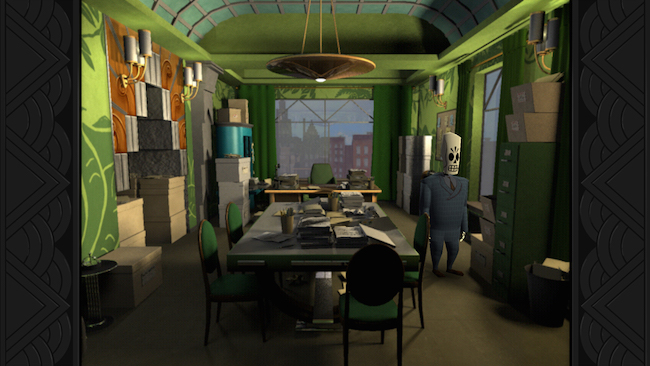
Grim Fandango’s art design is to die for (sorry). The mix of art deco, Aztec imagery and of course the film noir influence comes together beautifully to build a unique yet familiar world that mixes the mundane with the extraordinary. Manny’s office is dingy, complete with shadows from the venetian blinds spilling across the floor and 1930s era décor, while Manny himself does his best work in a fine suit and won’t let being at the bottom of the ocean stop him from having a smoke. Each section of the game falls on the Day of the Dead each year, a Mexican holiday to celebrate the dead, and as such the characters are modelled on the calaca figures used in the celebrations. The effect allowed the designers to create easily recognisable characters (telling one skull from another in real life is usually left to the experts) while also enriching the setting further in the cultural aspects of the game. Players are eased into the game’s lore without much cajoling and isn’t overly complicated. Manny’s companion Glottis introduces the concept of demons that are created for specific purposes (in his case fixing cars and driving fast), which adds a nice extra layer of narrative and colour to the story.
The remastering sharpened up the character models, but the prerendered backgrounds – while still gorgeous – did not receive the same treatment and as such lack the same resolution quality. This can be an issue in some situations when interactive objects are a part of prerendered scenery and can be difficult to discern. The visuals may possibly be a barrier for some people depending on their tolerance for nostalgia, but it’s hard to deny Grim Fandango’s charm. The music of Grim Fandago is pretty much everything you’d want it to be: swinging big band brass to shady tunes best played around lone streetlamps on a foggy night. The soundtrack on Remastered is performed by the Melbourne Symphony Orchestra, which of course means we can now claim Grim Fandango and by extension Tim Schafer as Australian! Hooray!
 A fantastically crafted word
A fantastically crafted word
 Memorable characters
Memorable characters
 Point-and-click controls!
Point-and-click controls!
 Great Soundtrack
Great Soundtrack
 Art design to die for
Art design to die for
 Obtuse puzzles can be frustrating
Obtuse puzzles can be frustrating
 Prerendered backgrounds still low resolution
Prerendered backgrounds still low resolution
 Unwieldy inventory system
Unwieldy inventory system
 Glottis can be incredibly annoying
Glottis can be incredibly annoying
Does it hold up? Mostly. The story is solid and the characters are charming, yet there’s niggling, annoying issues throughout that today we’d consider to be massive deal-breakers. We often let nostalgia cloud our opinions, especially when we’re talking about games that have otherwise been inaccessible for some time. It might just be that Grim Fandango will appeal to many, but disappoint a few when it’s laid out in front of them – bones and all. For those hankering for the point-and-click adventures of old, Grim Fandango: Remastered is a fun and rewarding experience. For others it might just be considered a museum piece: some might get it, others may say it should return to its box, but hopefully it will open some minds to the diverse works of our shared hobby.
Disclaimer: this game was provided to us by the developer, and reviewed on PC across 12 hours of gameplay.











